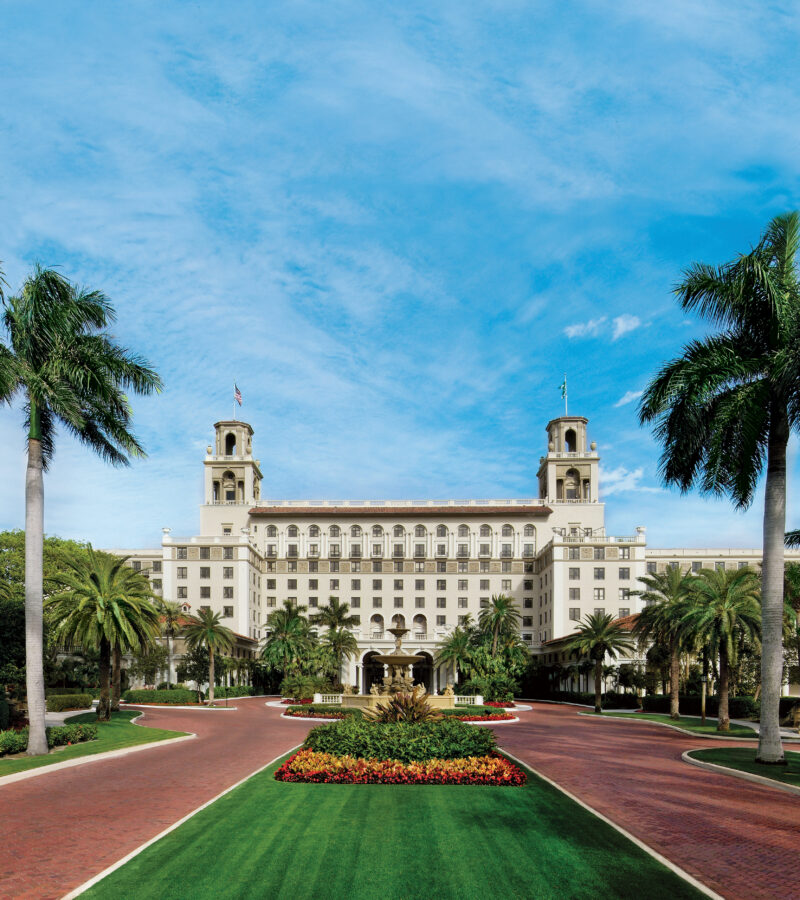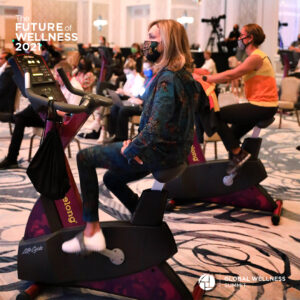
Trend #7
Resetting Events with Wellness
You may never sit on a banquet chair again
By Nancy Davis
Introduction
In mid-March 2020, many activities came to an abrupt halt; one of them was in-person events. It was obviously no longer safe to gather, ironically at a time when human connection was needed more than ever. And no matter the power of technology and the gratitude we all felt for our Wi-Fi connectivity, we hungered for personal interactions.
However, from South by Southwest to global tech conferences, everything was being cancelled. The economic impact of these event cancellations has been estimated at $22 billion and climbing.1
The pandemic paradigm shifted everything.
As the months passed, several conflicting issues converged in the world of meetings and events: a pent-up desire to travel; the still-spreading coronavirus; the uptick in virtual technologies; coupled with the unending human desire and need for connection. While gatherings were abruptly cancelled, the strong evolutionary drive to be social was becoming more evident.
As Dr. Vivek Murthy, 19th US Surgeon General, recently re-appointed Surgeon General for the Biden administration, and author of Together: The Healing Power of Human Connection in a Sometimes Lonely World said in his keynote interview at the 2020 Global Wellness Summit: “…Whenever you can bring people together, where they can understand one another more clearly by sharing, where they have opportunities to help one another which strengthens connection, then you are helping to build community; you’re contributing to healing. And you’re helping to create the kind of connected, cohesive world that all of us really need, for us and for future generations.”
A New Trend Emerges – with Wellness at the Core
But there is a silver lining, and a new trend has emerged that will forever change meetings and events: reinventing and reimagining how we gather. One smart way to do that is with wellness at the core, not just in form, but in content as well. People are seeking ways to embrace wellness, and new models of thoughtfully choreographed events with wellness could be just the “nudge” they need. This trend reinforces the importance of what is now top of mind everywhere—health, safety, strengthening immunity, and employing protocols and technologies that can mitigate risk. All of this underscores what is good for people—delivered in a creative and engaging way.
Examples of the Trend
Technology Companies Become Creative with Technology Solutions in a Hybrid Event Era
Alon Alroy, one of the co-founders of “Bizzabo—an online platform to plan and run both virtual and in-person conferences that recently closed an investment round of $138 million”2 explained it this way.
“The evolution of the event industry is divided into three eras: until March of 2020, it was the ‘In Person Era.’ Now we are in a period we call the ‘Virtual Transition Era.’ Live is still not an option in most of the world. We recently surveyed3 400 strategic, enterprise event planners, and it was clear that the vast majority of them want to go back to live events, but they all think Hybrid (virtual and live) is the future. In 2021, a new era is starting—the ‘Hybrid Event Era.’”
Alroy and his colleagues believe that every event will eventually be hybrid—and they’ve bet their future on it. Although he jokes that, “not everything translates well to a hybrid experience…lunch for example.”
Alroy was candid about what happened to the event business at the beginning of March 2020, and what has happened since. “The pandemic really disrupted the event industry and created a lot of innovation and opportunity to transform the space.” To reduce cash burn Bizzabo put 25% of the company on furlough by the end of March. Alroy says it was the hardest time in the history of the company. (Bizzabo is headquartered both in Tel Aviv and New York and is filled with friends who have worked together for years.) Bizzabo also took hold of their future and placed a Vegas-sized bet on virtual events before it was “a thing.” It took them just three weeks to pivot and adapt their platform to support virtual events.
The pivot paid dividends—literally. Within weeks, the sales started rolling in; their customers felt saved—they were relevant again. By mid-May, Alroy and his colleagues moved from defense to offense, and achieved their goal—they could bring back all of their furloughed friends, and by the end of June, they were hiring.
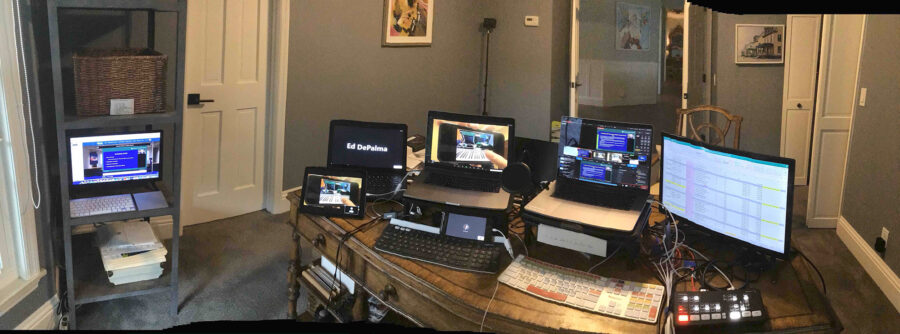 The Black Point Pivot
The Black Point Pivot
Ed and Sue DePalma, co-founders of Black Point Creative, a boutique agency with a client roster that reads like a page out of Forbes, shared this in a recent interview: “In 2020, pre-COVID, we were poised to produce over 50 corporate programs. In the blink of an eye, as we all began to understand the consequences of the pandemic, everything on our calendar was wiped out. Clients cancelled all meetings, bringing our work to a startling halt.”
Like Bizzabo, Black Point pivoted. “By April 2020, we had set up a virtual control room in our home office. There, in our new reality, live feeds come in from all over the world. Using state of the art software, we switch the feeds and create programs that look like news shows. The programs include presentations, conversations, interviews, and live questions. Our home ‘control room’ is ‘live’ at least 6 days a week, for an average of 14 hours a day.”
Wellness World Weighs In to Improve Engagement and Results
The virtual aspect of hybrid events will continue to be refined, and there are sophisticated plans in the works as all the players continue to scramble for new market share. But if COVID-19 has taught us anything, it’s that while technology is at the center of many things, it’s not going to be enough when it comes to human connection and gathering.
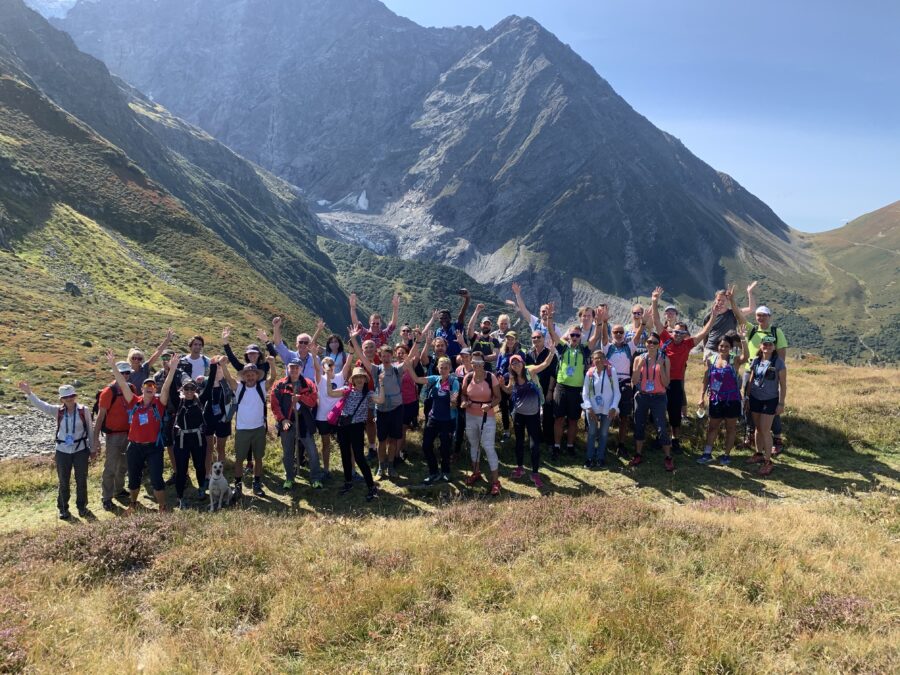 A great example of a wellness-infused event happens every year in the French Alps, and this year, they had to pivot. An elite group of global family offices meets annually atop the mountains in Chamonix, France. The Monthly Barometer’s “Summit of Minds” turned hybrid this year, out of necessity, just weeks before the event, when the borders closed between European countries.
A great example of a wellness-infused event happens every year in the French Alps, and this year, they had to pivot. An elite group of global family offices meets annually atop the mountains in Chamonix, France. The Monthly Barometer’s “Summit of Minds” turned hybrid this year, out of necessity, just weeks before the event, when the borders closed between European countries.
What distinguishes this event from most others, is that it is led by nature-evangelist Thierry Malleret, a global economist with a resume that includes having led the Global Risk Network at the World Economic Forum in Davos, Switzerland.
Thierry created “walkshops” where the hearty souls in attendance share ideas while scaling the Alps.
“Meeting and moving in nature is the most productive and creative way to exchange ideas and generate insights. The reason? It enhances our physical and mental wellbeing. At the Monthly Barometer Summit of Minds, we walk the talk!”
Creativity Is Driving Connection
A quick read of The Global Wellness Institute’s white paper “Resetting the World with Wellness: Human Connection in a Time of Physical Distancing”confirms that the pandemic has only exacerbated the global loneliness epidemic, often referred to as a “parallel pandemic.”
This means the in-person aspect of the hybrid event is another place to look for innovation. Among the myriad changes to life in 2020, people have become hyper-aware of prevention and health as a means to fight off what will no doubt be COVID 20, 21 and beyond.
Hybrid events were born of the struggle between safety and an unstoppable desire for connection, and right now it’s not only the best option, its an improved option from what was available in the past. And it is likely to be part of our future. Event industry professionals agree that hybrid is here to stay, and they also agree that in person remains the most impactful part of the hybrid. Therein lies an opportunity to incorporate wellness components that catapult gatherings to a better place than they were before the pandemic. How we gather is taking on new meaning.
Already, there is movement in this direction. Online platforms are gobbling up event companies, mobile app developers (Hopin buying Topi and StreamYard; Business Insider) and more as the hybrid is becoming the future.
Case in Point: The 2020 Global Wellness Summit (GWS)
Enter a real-life example of putting wellness at the center of an event and disrupting forever how we think about gathering. While this model was imagined and created by wellness industry experts, it became obvious to all who participated that the hybrid wellness model could apply to any gathering for any industry in the future. It was a creative hybrid event that surpassed even the creators’ expectations. Technology and wellness triumphed together and laid the foundation for the way forward.
“Pivot” was the word of 2020, and the GWS made its pivot very early in the year. The conference was originally scheduled for November in Tel Aviv but was moved to The Breakers Palm Beach in the United States—and became a smaller in-person event with a global, virtual component.
The GWS was not, at the time, willing to turn the event entirely “virtual,” as central to the organization’s DNA, and to evidence-based research, is the fact that being together, in person, is key to one’s wellbeing. Organizers were determined to have some people gather in person, if at all possible. Although the usual 600+ delegates from over 60 countries could not be present, a small portion would suffice.
Reimaging the Largest Conference on the Business of Wellness: The Birth of the Safe Summit.
1. Location: selecting one dedicated to health and safety A location was chosen where management cared as much about health and safety as the GWS did, which was The Breakers Palm Beach, where strict protocols were already in place and natural surroundings contribute to an overall sense of wellbeing. In this case, the Atlantic Ocean, miles of beach, swaying palm trees.
Paul Leone, The Breakers’ CEO, and his team partnered with the Summit to bring the Safe Summit to life. “As we navigate this changing and uncertain landscape, challenges such as COVID-19 require us to be entrepreneurial, flexible, and to continue to go above and beyond in evolving our best practices,” said Leone. “Everything we do is motivated by our commitment to provide a safe and comfortable environment for our team, guests, clients and community, which remains our top priority. Our longstanding partnership with the GWS, supported by the resort’s comprehensive B Safe – Health & Safety Initiative, served as the foundation for the program.”
2. Medical oversight: collaborating with a renowned medical expert to advise on protocols The GWS partnered with an expert in the medical field to review the protocols and processes they were planning to implement. In this case, they had the best: Richard Carmona, 17th US Surgeon General and member of the Global Wellness Institute Board of Directors. Dr. Carmona flew from Arizona to The Breakers to attend in person.
The Summit insisted on mandatory, on-site, rapid COVID testing. All delegates who tested negative—and all delegates did test negative—were given a wrist band to wear throughout the event. Premier Family Health provided the testing, as well as on-site medical advisors to answer any questions and deal with any issues.
Every delegate had their temperature taken every morning before they could enter the main stage session. Masks were mandatory, even onstage. Social distancing was strictly enforced, and hand sanitizing stations were available throughout the resort.
3. The air we breathe: ground-breaking cleaning, sanitization and circulation
technologies There was pioneering technology cleaning the air, removing viral loads from clothing and skin, and purifying and sanitizing the meeting spaces. Everything from custom-engineered entry portals to the ballroom using Far UVC lighting, to signage that sanitized air when it recognized motion, to constant purification and circulation of air. Healthē by Lighting Science and Delos Air Purification Solutions became essential partners for this safe gathering.
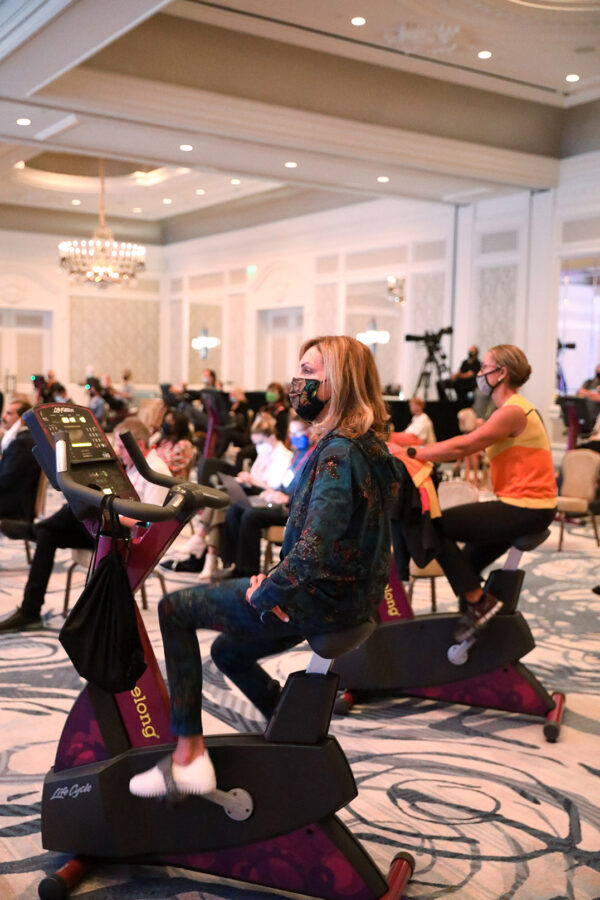 4. Please take your seats…or bikes: adding cardio equipment in the main meeting room
4. Please take your seats…or bikes: adding cardio equipment in the main meeting room
One way in which the GWS truly disrupted the event space, was, well, the event space itself! Since they knew the Summit had to adhere to strict social distancing guidelines, they turned a potential negative into a positive. How to reimagine the ballroom and its vast square footage so it wouldn’t appear empty?
Knowing that movement and fitness were key to overall health and wellbeing and knowing that there would be a smaller group of in-person delegates—and the desire to create a sense of togetherness and community, even under these circumstances, organizers reset the room with natural wellness zones. In true collaboration with Planet Fitness, through Victor and Lynne Brick, of the John W. Brick Mental Wellness Foundation, they created individual “wellness stations,” where delegates could opt to experience the Summit while balancing on a stability ball, moving gently on an elliptical, pedaling on a recumbent bike, or sitting on a traditional banquet chair.
“Nudge Wellness” was all the rage, and very few people sat on banquet chairs.
“Nudge Wellness” is a relatively new term that is meant to inspire healthy behavior by making wellness choices readily accessible and clearly visible. In this case, using a recumbent bike required nothing more than walking into the room and choosing it. No sign-ups, no special training (though trainers were there throughout the event), no obstacles.
In the spirit of movement, and also of creating community, Dr. Phyllis Hubbard led the group in moments of “radiant movement” at the beginning of several of the general sessions to encourage focus, relaxation and general wellbeing.
5. More nudge wellness: healthy meals and snacks throughout
The GWS worked with The Breakers’ chef and banquet department to create meals and energy breaks where health and immunity were the central themes. The snacks were Individually wrapped, perfect for takeaway, and handed to delegates by the gloved banquet staff in an elegant choreography that made you forget the reason for all the precautions. It helped that the food was as delicious as it was beautiful.
6. Walking the walk: modeling safe protocols from the stage
Everyone was masked. Every podium and hand-held microphone was sanitized between use. Every panel chair was wiped down during breaks, and careful measuring was done to ensure safe distances between panelists. Seating areas in the ballroom were sprayed, and special sanitizing light was used whenever there was a moment to do so.
7. Creativity center stage: content curation, delivery and engagement
Organizers made sure that the all-important wellness tenet of connection was not lost in a year when loss was on everyone’s mind.
The GWS pre-recorded a good deal of the keynotes and some panels but had a “live” component that corresponded; this ensured a smooth technical process and kept the audience engaged—they could submit questions in real time to the speaker or panel. Wellness pioneer Anna Bjurstam acted as “global emcee” from her home in Sweden, anchoring the virtual aspect of the event, curating questions on the fly, and then showing up via Zoom at the Summit to actively participate.
After most of the recorded keynotes, that speaker appeared live to answer questions.
There was a fast-paced combination of elements, mixing on-site and virtual with the goal of integrating the entire global audience so virtual attendees and in-person Summit delegates felt like they were at one event. Live keynotes, pre-recorded keynotes, virtual keynotes, on-site breakout sessions and virtual breakout sessions all contributed to a lively cadence throughout the three-day event.
Concurrent to breakout sessions on-site at The Breakers—complete with expert leaders, modeling clay, markers and pipe cleaners to inspire creative thinking—virtual breakout sessions took place in other time zones to accommodate the global participants.
Committed to delivering added value to those who joined in person, the GWS created live, spontaneous elements, including “call-ins” from wellness leaders—Bob Roth, CEO, David Lynch Foundation; Arianna Huffington, CEO, Thrive Global; Deborah Szekely, Founder, The Golden Door & Rancho LaPuerta; and Neil Jacobs, CEO, Six Senses Hotels Resorts Spas, to name a few. Each would appear live via Zoom, after the sound of a telephone ringing, and would interact for five minutes with Susie Ellis, chair and CEO. This was a fun surprise every time and added to the energy of the event.
A number of powerful business titans and investors were present at The Breakers and participating virtually; they were excited about and interested in all the innovation they were seeing. Rather than the usual situation where a company pitches investors, organizers turned the tables and had the investors pitch the companies. It was wildly popular and has turned into an ongoing program the GWS will launch in the first quarter of 2021.
8. Consistent, Considered Communication: Before, during, after for all in-person and virtual participants
Campaigns were developed to communicate the unique nature of the event, the value of participation, and the opportunity to contribute even as a virtual attendee. Keynotes and panels were announced, sponsors spotlighted, health and safety protocols reinforced, and a “global audience” created. In a year of great uncertainty, communication was key to helping people feel part of something important.
The tentpoles of the wellness world were expanded and being inclusive remained a priority. The obvious advantage of a virtual component is the reach; in a year when travel was all but gone, being able to attend from afar was a great opportunity for the hosts and for those who usually attend in person but could not be present. Then there was the added bonus of those who always wanted to be part of this event but were not previously invited. As an invitation-only event, the GWS decided this year, for the virtual component, anyone could join.
9. Business Must Get Done: Ensuring opportunities and showcases
Rather than doing less, the Summit expanded. After all, never before has wellness been more needed and emphasized. Each of the 11 sectors of the wellness economy—Personal Care, Beauty and Anti-Aging; Physical Activity; Healthy Eating, Nutrition and Weight Loss; Wellness Tourism; Preventive and Personalized Medicine and Public Health; Traditional and Complementary Medicine; Wellness Real Estate; Mental Wellness; Spa Economy; Thermal/Mineral Springs; Workplace Wellness—had tremendous needs and vast opportunities. Therefore, facilitating collaboration and business opportunities was a vital contribution to the entire industry. Wellness technology was exploding; wellness architecture, real estate and communities
were in high demand; and many of the other sectors needed to find new revenue streams. Entrepreneurs and small-large companies sought solutions to the problems brought to the forefront by the pandemic.
Therefore, the GWS launched a “Call for Wellness Innovations” competition and awarded the first-ever Global Wellness Prize for Innovation to Amai Proteins out of Israel.4
They also launched the “Tech Innovation Pavilion”5 on-site at The Breakers, and global companies showcased their most recent innovations to the assembled group, as well as through short-form videos from the Pavilion shared with the global, virtual audience.
10. All Work and No Play: Wellness also includes joyful socializing
Evening events on-site at the 2020 Summit were limited by social distancing protocols but not limited by imagination.
“The Mask-erade!” event was one example of turning challenge into opportunity, as the assembled group enjoyed a wildly successful evening of “distanced disco dancing,” a live auction to benefit industry research, and a fine dining experience.
The Future of Gatherings: The marriage of technology and wellness
The future of the event industry is paved with technology, but the most impactful path will also be paved with wellness and the acknowledgment that one of the most important pillars of wellness is social interaction. Nothing will ever replace being together, in person. As reuniting returns, human contact will triumph, and technology will support and enhance the experience, rather than be the sole star of the show.
Event designers have an unusual opportunity to provide a new framework, a hybrid where in-person and virtual elements dance together and where wellness elements will be built-in to the event structure and content agenda.
That dance has already begun.
Endnotes
1 https://www.northstarmeetingsgroup.com/News/Industry/CEIR-Economic-Trade-Show-Impact-Coronavirus-COVID-19
2 https://techcrunch.com/2020/12/02/bizzabo-raises-138m-for-a-platform-that-helps-you-build-and-run-virtual-conferences/
3 https://www.bizzabo.com/event-resources
4 https://www.globalwellnesssummit.com/press/press-releases/gws-celebrates-winners-of-prestigious-awards/
5 https://www.globalwellnesssummit.com/press/press-releases/finalists-of-the-first-ever-global-wellness-summit-prize-for-innovation-announced/
Download this 2021 trend and receive the 2021 mid-year update as well. The 2022 Future of Wellness global trends report is now available. View the latest trends. Subscribe to our mailing list and receive the bi-weekly TRENDium, a compendium of the trends impacting the multi-trillion dollar global wellness economy featuring the latest news and insights. Sign-up to receive the TRENDium.

